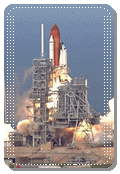
 Space
Space  A Space Shuttle Mission Countdown
A Space Shuttle Mission Countdown
Based on launch blogs displayed by NASA when a Space Shuttle mission is taking off from Florida, see how a Space Shuttle launch countdown proceeds! (note: a large part of that tutorial, or the texts linked to, are written at the present time; such passages and texts should be read at the past as the Space Shuttle program ended by the summer of 2011, as those texts might be, or not, adapted in a near future)

.The Launch of the Hubble Repair Mission
.The Launch of the STS-127 Space Shuttle Mission
.The Launch of the STS-131 Space Shuttle Mission
Here are, generally, countdown milestones until when the pages above are beginning their description (built-into countdown pauses or 'holds' are deviced to allow the
launch team to target a precise launch window, and to provide a cushion of time
for certain tasks and procedures without impacting the overall schedule. For a Space Shuttle countdown, built-in holds vary in length as they always occur at the
following times: T-27 hours, T-19 hours, T-11 hours, T-6 hours, T-3 hours, T-20
minutes, and T-9 minutes)
- between launch-3d and launch-43h, Shuttle Test Director performs the traditional call to stations as the countdown clock is activated. Final vehicle and facility close-outs for launch begin. Backup flight systems are checked out and flight software stored in mass memory units and display systems is reviewed as backup flight system software into the orbiter's general purpose computers is loaded. Other actions include: remove middeck and flight deck platforms, activate and test navigational systems, complete preparation to load power reactant storage and distribution system, and complete flight deck preliminary inspections
- by launch-27h, the first built-in hold occurs and typically lasts four hours. Following actions take place: clear launch pad of all non-essential personnel, begin loading cryogenic propellants into orbiter's power reactant storage and distribution (PRSD) system, begin operations to load cryogenic reactants into the orbiter's fuel cell storage tanks. Perform test of the vehicle's pyrotechnic initiator controllers and range safety system. The countdown then is resuming
- by launch-19h a new built-in hold occurs, typically lasting four hours, but may be extended if PRSD offload is required. Occur then: demate the orbiter's midbody umbilical unit, clean and vacuum crew module, External Tank nosecone purge
- by launch-19h and counting. Orbiter and ground support equipment closeouts resume with actions like begin final preparations of the orbiter's three main engines for main, propellant tanking and flight, fill launch pad sound suppression system water tank, close out the tail service masts on the mobile launcher platform
- by launch-11h. A new built-in hold begins which varies between 13 to 14 hours, with weather and engineering briefings, pad debris inspection and closeout, flight crew equipment late stow. The rotating service structure is moved to park position, the orbiter's inertial measurement units and communications systems activated and ascent switch list performed. Removal of pad ground support equipment occurs along with a main engine avionics, pneumatics and controller checkout, External Tank feedline inspection/camera cleaning. Engine support platforms are lowered and access platforms retracted
- by launch-11h and counting, activate the orbiter's fuel cells with a flow-through purge, clear the blast danger area of all nonessential personnel, switch the orbiter's purge air to gaseous nitrogen
- by launch-6h, a new built-in hold occurs, lasting 2 hours (or one hour for a 24- or 48-hour scrub). Mission Management Team and launch director receive weather update, launch team verifies no violations of launch commit criteria before loading the External Tank with propellants. Clear pad of all personnel. Chill-down of propellant transfer lines. Loading the External Tank begins
- by launch-6h and counting, finish filling the External Tank
- by launch-3h a built-in hold typically lasts two-and-a-half hours. External tank loading enters stable replenish. Perform inertial measurement unit preflight calibration, align Merritt Island Launch Area (MILA) tracking antennas. Final Inspection Team proceeds to the launch pad to conduct a detailed analysis of the vehicle as the team walks up and down the entire launch tower. Closeout Crew proceeds to the launch pad to configure the crew module for countdown and launch and assist the astronauts with entry into the orbiter. Televised weather briefing. Flight crew weather briefing. Astronaut Support Person enters crew module and begins comm checks
- by launch-3h and counting. Thence, the countdown resumes as the countdowns above are reattaching there!
Website Manager: G. Guichard, site 'Amateur Astronomy,' http://stars5.6te.net. Page Editor: G. Guichard. last edited: 12/28/2010. contact us at ggwebsites@outlook.com

